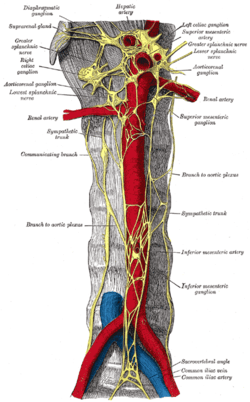Aortic bifurcation
| Aortic bifurcation | |
|---|---|
 The abdominal aorta and its bifurcation into the two common iliac arteries (red). | |
| Details | |
| Latin | Bifurcatio aortae |
Source | Abdominal aorta |
Branches | Common iliac arteries |
| Inferior vena cava | |
| Identifiers | |
| Gray's | p.613 |
| TA | A12.2.13.001 |
| FMA | 3795 |
| Anatomical terminology | |
The aortic bifurcation is the point at which the abdominal aorta bifurcates into the left and right common iliac arteries. The aortic bifurcation occurs usually at the level of the fourth lumbar vertebrae (L4 Vertebra),[1] just above the confluence of the left and right common iliac veins.
The right common iliac artery passes in front of the left common iliac vein. In some individual, mainly women with lumbar lordosis this vein can be compressed between the vertebra and the artery. This is the so-called Cockett syndrome or May-Thurner syndrome [2] can cause a slower venous flow and the possibility of deep venous thrombosis in the left leg mainly in pregnancy.
Additional images
-

The abdominal aorta and its branches.
-

Abdominal portion of the sympathetic trunk, with the celiac and hypogastric plexuses.
-

Posterior abdominal wall, after removal of the peritoneum, showing kidneys, supra-renal capsules, and great vessels.
References
- ↑ Lerona PT, Tewfik HH (June 1975). "Bifurcation level of the aorta: landmark for pelvic irradiation". Radiology 115 (3): 735. doi:10.1148/15.3.735. PMID 1129492.
- ↑ "Clinical presentations of Cockett's syndrome". Retrieved 2013-03-17.
| ||||||||||||||||||||||||||||||||||||||||||||||||||||||||||||||||||||||||||||||||||||||||||||